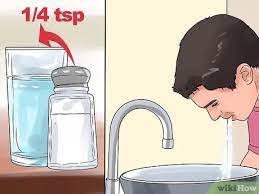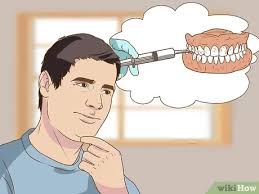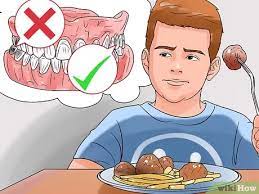After undergoing a wisdom tooth extraction, it is common for food particles to get trapped in the extraction site, leading to discomfort and potential complications. To ensure proper healing and prevent infection, it is important to remove food stuck in the wisdom tooth hole. Here are some effective methods to help you clean the extraction site:
- Gentle Rinsing: Rinse your mouth with a warm saltwater solution. Mix half a teaspoon of salt in a glass of warm water and swish it around your mouth, making sure to reach the extraction site. The saltwater helps in reducing swelling and disinfecting the area, while the gentle swishing motion can dislodge food particles.
- Irrigation Syringe: An irrigation syringe can be useful in dislodging food particles. Fill the syringe with warm salt water or an antibacterial rinse recommended by your dentist. Direct the stream of water into the extraction site, applying gentle pressure to flush out the trapped food.
- Dental Irrigator: A dental irrigator, also known as a water flosser, can be an effective tool for cleaning the extraction site. Fill the reservoir with warm salt water or an antibacterial rinse and use the device to direct a pulsating stream of water into the wisdom tooth hole, removing any food debris.
- Soft-Picks or Interdental Brushes: Soft picks or interdental brushes are small, flexible tools designed to clean between teeth. Choose a size that fits comfortably into the extraction site and gently maneuver it to remove any food particles. Be careful not to apply excessive force to avoid damaging the healing tissues.
- Dental Syringe: A dental syringe can also be used to flush out food from the wisdom tooth hole. Fill the syringe with warm salt water or an antibacterial rinse and direct the solution into the extraction site, aiming at the food particles to dislodge them.
Remember to follow your dentist’s post-operative instructions for oral hygiene and care. If you experience persistent pain, swelling, or signs of infection, consult your dentist for further evaluation and guidance.
What Can I Do If Food Gets Trapped in My Wisdom Tooth Hole?
If you have food trapped in your wisdom tooth hole, there are several steps you can take to alleviate the discomfort and remove the food particles. Follow these tips to address the issue effectively:
- Rinse with Warm Saltwater: Prepare a solution by dissolving half a teaspoon of salt in a glass of warm water. Take a sip of the salt water and swish it gently around the mouth, paying particular attention to the wisdom tooth extraction site. The warm saltwater helps in reducing inflammation and acts as a mild antiseptic to promote healing and eliminate bacteria.
- Use an Interdental Brush: Interdental brushes are small brushes designed to clean between teeth and are available in different sizes. Choose a brush that fits comfortably into the wisdom tooth socket and use gentle, back-and-forth motions to dislodge the trapped food particles. Avoid applying excessive force to prevent injury to the healing tissues.
- Try Dental Floss: If the food particle is visible and accessible, you can try using dental floss to remove it. Take a piece of dental floss, gently insert it into the wisdom tooth hole, and carefully maneuver it to dislodge the food. Be cautious not to cause any injury or irritation to the extraction site.
- Avoid Using Sharp Objects: While it may be tempting to use sharp objects such as toothpicks or tweezers to remove the food, it is best to avoid them. These instruments can potentially damage the healing tissues or push the food particle deeper into the socket
, leading to further complications.
- Seek Professional Help: If the food particle remains stuck or if you experience increasing pain, swelling, or signs of infection, it is important to seek professional dental care. Your dentist will be able to safely remove the food and provide any necessary treatment to ensure proper healing.
Remember to maintain good oral hygiene and follow your dentist’s post-operative instructions to minimize the risk of food getting trapped in the wisdom tooth hole. Regularly brushing and flossing your teeth, along with rinsing with an antibacterial mouthwash, will help keep the area clean and reduce the chances of food impaction.
Are There Any Home Remedies for Removing Food from a Wisdom Tooth Socket?
When food becomes trapped in a wisdom tooth socket, home remedies can be helpful in dislodging the particles and promoting oral hygiene. Here are some effective home remedies you can try to remove food from a wisdom tooth socket:
- Warm Saltwater Rinse: Prepare a warm saltwater solution by dissolving half a teaspoon of salt in a glass of warm water. Take a mouthful of the solution and swish it gently around your mouth, ensuring it reaches the wisdom tooth socket. The warm saltwater helps reduce inflammation, while the swishing action can dislodge food particles. Spit out the solution after rinsing.
- Antibacterial Rinse: An antibacterial rinse, recommended by your dentist, can help eliminate bacteria and reduce the risk of infection. Rinse your mouth with the prescribed antibacterial mouthwash, focusing on the wisdom tooth socket to help loosen and remove trapped food.
- Irrigation with a Syringe: Using a clean syringe, you can gently flush out the wisdom tooth socket with warm salt water or an antibacterial rinse. Fill the syringe with the solution, direct the stream into the socket, and apply gentle pressure to dislodge the food particles. Be cautious not to use excessive force, as it may cause damage.
- Water Flosser or Dental Irrigator: A water flosser, also known as a dental irrigator, can effectively remove food particles from the wisdom tooth socket. Fill the reservoir with warm salt water or an antibacterial rinse and direct the pulsating stream of water into the socket to flush out the debris.
- Soft-Picks or Interdental Brushes: Soft picks or interdental brushes can be used to gently remove food particles from the wisdom tooth socket. Select a size appropriate for the socket and carefully maneuver the brush or pick to dislodge the trapped food. Be gentle to avoid causing any injury.
Remember that these home remedies are meant to provide temporary relief and should not replace professional dental care. If the food particles persist or you experience signs of infection, such as severe pain, swelling, or fever, it is crucial to seek dental attention to prevent complications.

How Long Does It Take for Food to Naturally Come Out of a Wisdom Tooth Hole?
After wisdom tooth extraction, the healing process typically takes several weeks. During this time, any food particles that get trapped in the wisdom tooth hole will gradually be dislodged or dissolved on their own. The time it takes for food to naturally come out of a wisdom tooth hole can vary depending on various factors, including the individual’s healing process, oral hygiene practices, and the complexity of the extraction.
On average, it may take anywhere from a few days to a couple of weeks for the food to naturally dislodge from the wisdom tooth hole. As the extraction site heals, the tissues inside the socket go through a process called granulation, where new tissue forms and gradually replaces the blood clot that initially formed after the extraction. During this time, any trapped food particles will be pushed out or broken down by enzymes present in saliva
After undergoing a wisdom tooth extraction, it is common for food particles to get trapped in the extraction site, leading to discomfort and potential complications. To ensure proper healing and prevent infection, it is important to remove food stuck in the wisdom tooth hole. Here are some effective methods to help you clean the extraction site:
- Gentle Rinsing: Rinse your mouth with a warm saltwater solution. Mix half a teaspoon of salt in a glass of warm water and swish it around your mouth, making sure to reach the extraction site. The saltwater helps in reducing swelling and disinfecting the area, while the gentle swishing motion can dislodge food particles.
- Irrigation Syringe: An irrigation syringe can be useful in dislodging food particles. Fill the syringe with warm salt water or an antibacterial rinse recommended by your dentist. Direct the stream of water into the extraction site, applying gentle pressure to flush out the trapped food.
- Dental Irrigator: A dental irrigator, also known as a water flosser, can be an effective tool for cleaning the extraction site. Fill the reservoir with warm salt water or an antibacterial rinse and use the device to direct a pulsating stream of water into the wisdom tooth hole, removing any food debris.
- Soft-Picks or Interdental Brushes: Soft picks or interdental brushes are small, flexible tools designed to clean between teeth. Choose a size that fits comfortably into the extraction site and gently maneuver it to remove any food particles. Be careful not to apply excessive force to avoid damaging the healing tissues.
- Dental Syringe: A dental syringe can also be used to flush out food from the wisdom tooth hole. Fill the syringe with warm salt water or an antibacterial rinse and direct the solution into the extraction site, aiming at the food particles to dislodge them.
Remember to follow your dentist’s post-operative instructions for oral hygiene and care. If you experience persistent pain, swelling, or signs of infection, consult your dentist for further evaluation and guidance.
What Can I Do If Food Gets Trapped in My Wisdom Tooth Hole?
If you have food trapped in your wisdom tooth hole, there are several steps you can take to alleviate the discomfort and remove the food particles. Follow these tips to address the issue effectively:
- Rinse with Warm Saltwater: Prepare a solution by dissolving half a teaspoon of salt in a glass of warm water. Take a sip of the salt water and swish it gently around the mouth, paying particular attention to the wisdom tooth extraction site. The warm saltwater helps in reducing inflammation and acts as a mild antiseptic to promote healing and eliminate bacteria.
- Use an Interdental Brush: Interdental brushes are small brushes designed to clean between teeth and are available in different sizes. Choose a brush that fits comfortably into the wisdom tooth socket and use gentle, back-and-forth motions to dislodge the trapped food particles. Avoid applying excessive force to prevent injury to the healing tissues.
- Try Dental Floss: If the food particle is visible and accessible, you can try using dental floss to remove it. Take a piece of dental floss, gently insert it into the wisdom tooth hole, and carefully maneuver it to dislodge the food. Be cautious not to cause any injury or irritation to the extraction site.
- Avoid Using Sharp Objects: While it may be tempting to use sharp objects such as toothpicks or tweezers to remove the food, it is best to avoid them. These instruments can potentially damage the healing tissues or push the food particle deeper into the socket.
- Seek Professional Help: If the food particle remains stuck or if you experience increasing pain, swelling, or signs of infection, it is important to seek professional dental care. Your dentist will be able to safely remove the food and provide any necessary treatment to ensure proper healing.
Remember to maintain good oral hygiene and follow your dentist’s post-operative instructions to minimize the risk of food getting trapped in the wisdom tooth hole. Regularly brushing and flossing your teeth, along with rinsing with an antibacterial mouthwash, will help keep the area clean and reduce the chances of food impaction.

Are There Any Home Remedies for Removing Food from a Wisdom Tooth Socket?
When food becomes trapped in a wisdom tooth socket, home remedies can be helpful in dislodging the particles and promoting oral hygiene. Here are some effective home remedies you can try to remove food from a wisdom tooth socket:
- Warm Saltwater Rinse: Prepare a warm saltwater solution by dissolving half a teaspoon of salt in a glass of warm water. Take a mouthful of the solution and swish it gently around your mouth, ensuring it reaches the wisdom tooth socket. The warm saltwater helps reduce inflammation, while the swishing action can dislodge food particles. Spit out the solution after rinsing.
- Antibacterial Rinse: An antibacterial rinse, recommended by your dentist, can help eliminate bacteria and reduce the risk of infection. Rinse your mouth with the prescribed antibacterial mouthwash, focusing on the wisdom tooth socket to help loosen and remove trapped food.
- Irrigation with a Syringe: Using a clean syringe, you can gently flush out the wisdom tooth socket with warm salt water or an antibacterial rinse. Fill the syringe with the solution, direct the stream into the socket, and apply gentle pressure to dislodge the food particles. Be cautious not to use excessive force, as it may cause damage.
- Water Flosser or Dental Irrigator: A water flosser, also known as a dental irrigator, can effectively remove food particles from the wisdom tooth socket. Fill the reservoir with warm salt water or an antibacterial rinse and direct the pulsating stream of water into the socket to flush out the debris.
- Soft-Picks or Interdental Brushes: Soft picks or interdental brushes can be used to gently remove food particles from the wisdom tooth socket. Select a size appropriate for the socket and carefully maneuver the brush or pick to dislodge the trapped food. Be gentle to avoid causing any injury.
Remember that these home remedies are meant to provide temporary relief and should not replace professional dental care. If the food particles persist or you experience signs of infection, such as severe pain, swelling, or fever, it is crucial to seek dental attention to prevent complications.
How Long Does It Take for Food to Naturally Come Out of a Wisdom Tooth Hole?
After wisdom tooth extraction, the healing process typically takes several weeks. During this time, any food particles that get trapped in the wisdom tooth hole will gradually be dislodged or dissolved on their own. The time it takes for food to naturally come out of a wisdom tooth hole can vary depending on various factors, including the individual’s healing process, oral hygiene practices, and the complexity of the extraction.
On average, it may take anywhere from a few days to a couple of weeks for the food to naturally dislodge from the wisdom tooth hole. As the extraction site heals, the tissues inside the socket go through a process called granulation, where new tissue forms and gradually replaces the blood clot that initially formed after the extraction. During this time, any trapped food particles will be pushed out or broken down by enzymes present in saliva






